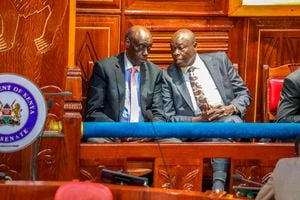Different uniform for junior high an unnecessary cost?

A row is looming over a proposal by the government to introduce new school uniforms for the 1.2 million junior secondary school (JSS) learners.
A row is looming over a proposal by the government to introduce new school uniforms for the 1.2 million junior secondary school (JSS) learners.
According to a source who spoke to the Nation, the government wants the learners to wear different school uniforms to distinguish them from their counterparts at the primary level.
An official who attended a stakeholder meeting at the Kenya Institute of Curriculum Development in Nairobi said the uniform issue featured prominently in the discussions that centred on JSS.
However, a quick rider was introduced that the lack of uniforms should not be a deterrent for learners to join schools.
The meeting, which was attended by teacher union officials, Ministry of Education officers and other stakeholders, discussed draft guidelines for JSS rollout.
By the time of going to press, Education Cabinet Secretary Ezekiel Machogu and Principal Secretary Belio Kipsang were yet to respond to inquiries regarding the uniforms.
“The uniform issue was discussed, that for identification it’s preferable to have different uniforms. All education directors were also present. The CS and PS presided. The draft regulations document is, however, still a work in progress,” the source said.
"No big deal"
In an interview yesterday, Kenya National Union of Teachers (Knut) Secretary-General Collins Oyuu said the proposal is not a big deal.
“The same parents would have bought new uniforms for their children when the learners join Form 1, so what will be the extra cost?” asked Mr Oyuu in an interview with the Nation on phone.
“There must be a distinction between the learner in JSS and those in primary, even if they are in the same compound. The government is right on the proposal,” he added, noting that uniforms should be mandatory and parents should prepare to buy them.
However, he said parents should not be forced to buy uniforms for the learner to be admitted.
“We must learn how to balance the act. If there are parents who cannot afford uniforms and it is proven, teachers must mobilise the community to help them. But we shall not allow parents to be too careless, you can afford but you say it is not a must, that is indiscipline,” said the unionist.
However, National Parents Association chairman Silas Obuhatsa said a different uniform is not necessary for the Grade 7 learners adding that they can be allowed to wear the same ones they wore in Grade 6. He said parents should be protected from exploitation due to the high costs of school uniforms.

National Parents Association Chairman David Obuhatsa Silas (centre) with other officials outside the Milimani Law Courts in Nairobi on September 20, 2022. Mr Obuhatsa says different uniforms for junior high learners are not necessary.
“The police and nurses have common uniforms. Uniform does not contribute to the performance of a child in school, it is like going to an office with or without a tie but you perform your duties. The question of children having different uniforms in Kenya has been a problem because the cost differs, some are very expensive and sold at specific shops,” said Mr Obuhatsa.
High cost of living
He explained that the rollout of JSS is happening at a time when Kenyans are grappling with the high cost of living and a battered economy.
“Parents should be given leeway, those that can afford uniforms should buy, those who cannot can still go on with their Grade 6 uniforms from the primary schools they are transitioning from. The question of uniforms should not bar children from transitioning,” he added.
At the same time, the Education stakeholders lauded the government for barring primary schools that lack the capacity from hosting JSS.
A multi-agency team led by the regional and county education directors has begun assessing the suitability of primary schools across the country to admit JSS learners ahead of schools reopening for the first term on January 23.
The 1.2 million Grade 7 learners will join the learning institutions on January 30.
In an interview with the Nation, Mr Oyuu acknowledged that some schools do not have structures to host JSS.
“In that case then, the government should move those learners to other schools. But this is not permanent, at least every school should host JSS because it was to be domiciled in primary schools, we must at all levels maintain that transition is 100 per cent, more so from primary to JSS,” said Mr Oyuu.
He added: “So when we say this school cannot host them and we move to another, we are not so sure whether the transition will be 100 per cent.”
But Mr Obuhatsa said some schools lack adequate infrastructure to accommodate students transitioning to junior secondary school.
“Even putting up a laboratory will be very difficult. As parents, we support the state’s decision to move learners to schools that have the capacity and infrastructure to host junior secondary schools. All the learners should be accommodated,” he said.





